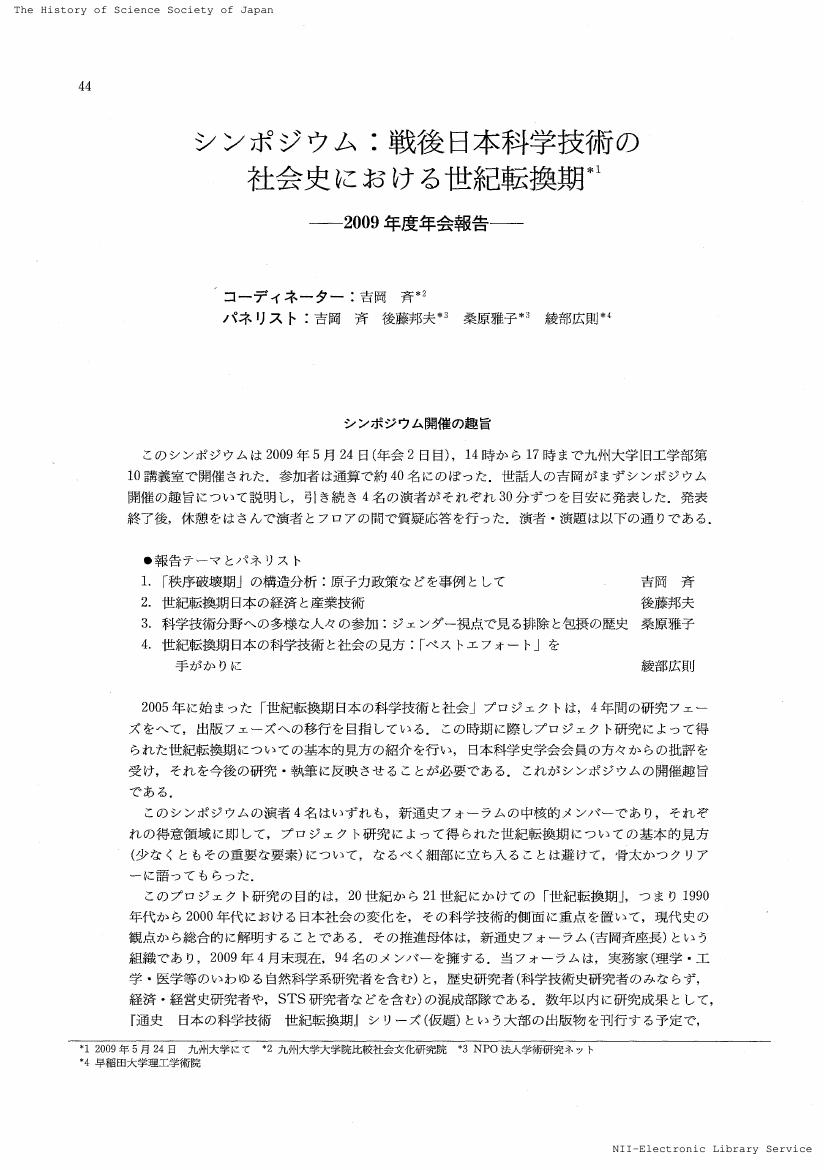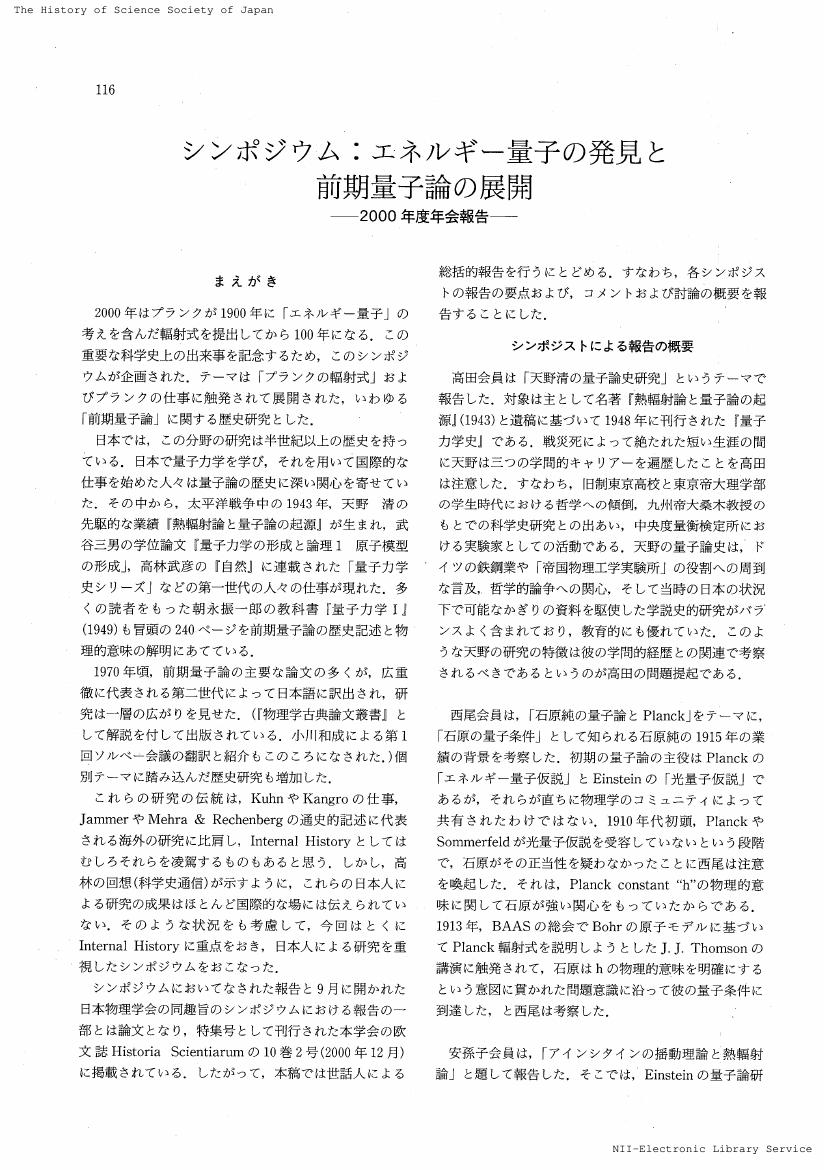- 著者
- 後藤 邦夫
- 出版者
- 科学技術社会論学会
- 雑誌
- 科学技術社会論研究 (ISSN:13475843)
- 巻号頁・発行日
- vol.15, pp.171-176, 2018-11-20 (Released:2019-12-02)
- 参考文献数
- 4
1 0 0 0 OA 「科学技術社会論」における「社会」をめぐる考察
- 著者
- 後藤 邦夫
- 出版者
- 科学技術社会論学会
- 雑誌
- 科学技術社会論研究 (ISSN:13475843)
- 巻号頁・発行日
- vol.15, pp.13-26, 2018-11-20 (Released:2019-12-02)
- 参考文献数
- 23
科学技術社会論を科学技術と社会の内在的な関係を扱い,社会科学の方法によって科学技術を批判するメタ的学問と規定する.その上で,古典的な社会理論の枠組み:資本,国家,市民社会=公共圏,共同体を軸として考察する.それらの変化が科学技術をめぐる活動に及ぼしてきた状況を,「総力戦体制」から「ポスト冷戦期」にかけて追跡する.特に,新しい学問である科学技術社会論が受けた変化を述べ,科学技術が国家と資本を軸に扱われ,公共圏と共同体と関連する考察が,特に日本において忘却されてきたことを指摘する.最後に,当面の課題として,社会の構成の基盤であるコミュニケーション・メデイアの疎外態としてのICT-AIの批判的考察の重要性を指摘する.
1 0 0 0 OA シンポジウム:戦後日本科学技術の社会史における世紀転換期,2009年度年会報告
1 0 0 0 OA シンポジウム:日本のコンピュータ史 研究開発における諸機関の連携-2008年度年会報告-
1 0 0 0 OA エネルギー量子の発見と前期量子論の展開 : 2000年度年会報告
- 著者
- 後藤 邦夫
- 出版者
- 日本科学史学会
- 雑誌
- 科学史研究 (ISSN:21887535)
- 巻号頁・発行日
- vol.40, no.218, pp.116-117, 2001 (Released:2021-08-17)
1 0 0 0 OA 20世紀物理学史試論 : 2000年度年会報告
- 著者
- 後藤 邦夫
- 出版者
- 日本科学史学会
- 雑誌
- 科学史研究 (ISSN:21887535)
- 巻号頁・発行日
- vol.40, no.217, pp.41-48, 2001 (Released:2021-08-17)
1 0 0 0 OA GrayanotoxinIIIのアセチル化におけるヒドロキシル基の反応性
- 著者
- 清野 公師 寺井 忠正 後藤 邦夫
- 出版者
- 公益社団法人 日本化学会
- 雑誌
- 日本化学会誌(化学と工業化学) (ISSN:03694577)
- 巻号頁・発行日
- vol.1991, no.2, pp.149-152, 1991-02-10 (Released:2011-05-30)
- 参考文献数
- 9
GrayanotoxinIII (3,5,6,10,14,16-hexahydroxygrayanotoxane ,G-III) は 3,6,14 位に第二級ヒドロキシル基,また, 5,10,16 位に第三級ヒドロキシル基の合計6つのヒドロキシル基をもつ四環性ジテルペノイドである。本報においては,0~100℃ の間に5段階の反応温度を設定し G-III を無水酢酸-ピリジンによりアセチル化反応を行うとともに,その反応経過を詳細に検討した。その結果,ヒドロキシル基のアセチル化に対する反応性は,6位が最も高く,以下,3位,14位,16位の順であった。この中で,6位のヒドロキシル基の反応性は極めて高く,0℃ではこれのみが選択的にアセチル化された。一方,3-OHと14-OHのアセチル化速度の比は,100℃においては 5 : 2 であったが,低温になるにつれその比が減少し,20℃では約 1:1 となった。さらに,第三級ヒドロキシル基については77℃以上で反応した結果,16位のみがアセチル化された。以上の結果から,この反応は逐次競争反応にしたがい進行することが判明した。
1 0 0 0 力学史 . 電磁気学史 . 光学史 . 物理学の未来 . 年表
- 著者
- 菅原仰[著] . 広重徹[著] . 後藤邦夫 高林武彦[著] . 植村泰忠[ほか]著 . 鎮目恭夫 八木江里[著]
- 出版者
- ダイヤモンド社
- 巻号頁・発行日
- 1963
- 著者
- 綾部広則 佐藤靖 桑原雅子 後藤邦夫 菅波完 黒田光太郎 川野祐二
- 出版者
- 日本科学史学会
- 雑誌
- 科学史研究 (ISSN:21887535)
- 巻号頁・発行日
- vol.57, no.288, pp.324-334, 2019 (Released:2021-01-24)
- 著者
- 津田 龍佑 篠崎 徹 田神 昭 後藤 邦夫 高松 薫
- 出版者
- 一般社団法人 日本体育学会
- 雑誌
- 体育学研究 (ISSN:04846710)
- 巻号頁・発行日
- vol.52, no.5, pp.405-417, 2007 (Released:2007-10-25)
- 参考文献数
- 22
- 被引用文献数
- 1
The purpose of this study was to examine the effect of playing mini-games of soccer for improvement of physical fitness. The subjects were 21 students at I junior high school (I Group) and 22 students at S junior high school (S Group). Group I played a mini-game with changed rules, whereas group S played the full game, each over a period of three weeks (6 physical education classes). Before and after the classes, skill tests (passing and dribbling), fitness tests (150m sprint with changing direction ; 25m×6 times, rest interval 30s), and a test game were conducted. In addition, an after-class questionnaire on knowledge, how to learn and skill of soccer was conducted. The main results were as follows : 1) The results of the passing and dribbling tests were improved significantly after classes using the mini-game. There was no significant improvement in the results of the first set of 150-m sprints with a change in direction after classes in both group, whereas the mean time for 6 sprints was improved significantly after classes in both groups. 2) There were no significant differences in the number of ball touches, heart rate or RPE in test games after classes in both groups, whereas the total movement distance was decreased significantly after classes using the full game. 3) In the questionnaire after the test game, almost every item on technique (coordination), physical fitness and mentality tended to have a higher score after classes using the mini game. On the other hand, after classes using the full game each mentality-related item tended to have a higher score, whereas items related to technique (coordination) and physical fitness tended to score the same or lower. 4) In the questionnaire after the class, there was no wide difference in knowledge of soccer between both groups, whereas items related to how to learn and skill of soccer tended to score higher in the former than in the latter. These results suggest that improvement of energy-related physical fitness could be obtained without compromising students' interest, volition and attitude regardless of whether they played the mini-game or the full game, although use of the mini-game led to an effective improvement of technique (coordination) without decreasing students' consciousness of how to learn soccer skills.
1 0 0 0 日本の物理学関係資料について
- 著者
- 玉木 英彦 勝木 渥 木村 東作 後藤 邦夫 辻 哲夫 山口 重雄
- 出版者
- 一般社団法人日本物理学会
- 雑誌
- 日本物理學會誌 (ISSN:00290181)
- 巻号頁・発行日
- vol.36, no.11, pp.781-784, 1981-11-05
1 0 0 0 インターネットのトラヒック源のモデル化と測定による検証
1.Eコマースサイトのウェッブページのデザイン評価ウェブページに表示されるリンクを逐次選択しながらターゲット情報が提供されているページにたどり着く過程をMarkov連鎖確率過程としてモデル化した。各リンクが選択される確率は、認知工学の技法を用いて計算された百科事典の見出し語間の類似度データベースの検索から自動的に計算して決めることにした。例として、現実の3つの航空会社のiモード航空券予約サイトをMarkov連鎖でモデル化し、予約完了までに要する平均クリック数と操作時間を計算した。その結果、ユーザの習熟度に応じて、3社のサイトの効率の特徴に違いがあることを示した。2.セルラ移動体通信網におけるハンドオーバ数の評価と最適端末位置管理セルラ移動体通信網において、1つの通話中に横切るセルの数(ハンドオーバ数)を評価するモデルを再生過程という確率過程の理論を応用して構築した。また、セルラ移動体通信網においては、基地局が移動端末の位置を時々刻々に記録しておくことが必要であるが、そのコストを節約するために、端末が一定数のセルを横断するごとにページングにより位置を報告させるものとする。端末が通話中に横断するセルの数を遅延再生確率過程でモデル化し、位置管理のコストを最小にするような更新頻度を決定する方法を研究した。3.波長分割多重方式の光通信網における波長割り当てと経路選択の高速解法大規模な波長分割多重方式の光通信網において、送受信の要求が静的に与えられていると仮定するとき、波長割り当てと経路選択を高速で行なう2つのアルゴリズムを開発した。これらを、茨城県および関東地方のNTT電話局の位置から構成した仮想網に対して適用し、既存のアルゴリズムと比較すると、実行速度が格段に短いことが示された。
1 0 0 0 IR 〈わたしの講義〉障害のある人とスポーツ
- 著者
- 後藤 邦夫
- 出版者
- 筑波大学
- 雑誌
- 筑波フォーラム (ISSN:03851850)
- 巻号頁・発行日
- vol.60, pp.76-80, 2001-11
2000年10月18日、シドニーオリンピックメインスタジアムでは、世界123カ国から男子3015名、女子1018名合計4033名の選手が集まって、パラリンピックの開会式が繰り広げられた。日本からは151名の選手と89名の役員、総勢240名が選手団を編成し、メダルを目指して自己の限界に挑んだ。 ...
1 0 0 0 OA 〈依頼総説〉 特別支援教育と体育教員養成
- 著者
- 後藤 邦夫
- 出版者
- 筑波大学体育科学系
- 雑誌
- 体育科学系紀要 (ISSN:03867129)
- 巻号頁・発行日
- vol.31, pp.1-8, 2008-03
1 0 0 0 OA "STS"あるいは「科学技術研究」についてI(1)
- 著者
- 後藤 邦夫
- 出版者
- 桃山学院大学
- 雑誌
- 桃山学院大学人間科学 (ISSN:09170227)
- 巻号頁・発行日
- vol.10, pp.77-118, 1996-01-30
"Science and Technology." We are accustomed to accept this phrase as a single integrated concept, though the words "science" and "technology" have rather independent meanings in history. This is one of the remarkable characteristics of our time, now in a big transition. Since the 1970s, a newly emerging research area, science and technology studies, or science, technology and society, say "STS", has become evident. Scholarly activity in this area is increasing, but it is not yet as clearly defined as many established disciplines. Some of this research is likely an expression of critical concerns about contemporary science and technology and its social consequences, while others are often policy studies linked with government administrations. But, in any case, the important and actual concern of studies concentrates on the study of science and technology in a social context, or in social relations. As early as the 1930s, some important works had appeared to study the politics of science and technology. During World War II, wartime mobilization of scientists and engineers gave a new social character to science and technology. As a result, the social relations of science became an important issue among many scientists. Nevertheless, the recent increase of interest in STS has some special meanings. The situation is much different from the past, when the corresponding research was supported by a few scientists with their personal endeavors. On the other hand, while STS studies came to be accepted by the scientific community as a newly established discipline, the conception of science and technology has changed from those views prevalent in the 1930s and 1940s to the current conceptions; i. e. from an enlightened view to a relativist view. Thus, there are very diverse views on the nature of the progress of science and technology, in contrast to older views, in which progress was automatically accepted as good. This very diversification is bringing a kind of fancy goods store, or an intellectual climate of "anything goes", into the research. While this situation is an expression of activity in the emerging state of learning, some improvement will be necessary in the further development of these new studies. Once, this writer has published a monograph, "Science, Technology, and Society: a Japanese Perspective, 1993, IC2 Institute University of Texas at Austin", to express his opinion on these problems. He also proposed a framework to promote research activity in this important area. This series of articles composes an improved Japanese version of the monograph. This writer would select two parts from the four in original English version, and would complement them with some expla-nations for readers who are not always belonging to any science and technology community. Part one of this series offers a general outlook for STS and a proposal for a framework for the integration of existing ideas and methods to give a fundamental methodology of STS. Part two is to comprehend twentieth century science and technology as an application of that methodology. This is not a description of twentieth century science and technology itself, but a research program for further investigation. This article has first two chapters of the series: Chapter one addresses the need for STS and the key question of the integration of science and technology. Characteristics of modern science are transferred into the modern technology, and with thus acquired features of science and technology the modern society has been largely influenced. This is a particular condition of contemporary STS research. Chapter two summarizes the results of STS research including some historical description. History, philosophy, and sociology provide core methods in most STS studies in programs of universities in the United States and Europe. But these disciplines are widely diversified. The problem is in deciding what parts of these vast areas of knowledge are essential. Efforts to integrate multidisciplinary achievements are also discussed.
1 0 0 0 OA オットー・ノイラート覚え書き(3)(文学部創設10周年記念号)
- 著者
- 後藤 邦夫
- 出版者
- 桃山学院大学
- 雑誌
- 国際文化論集 (ISSN:09170219)
- 巻号頁・発行日
- vol.22, pp.131-148, 2000-12-20
The third, and final, part of this series deals with theoretical thinking of Otto Neurath, especially concentrating to his discussion on basic problems of scientific learning. This gives also an explanation of philosophical diversification of people of the Vienna Circle, or logical empiricism, which is often thought as a monolithic, rigorous, inflexible rationalist group. On the contrary, Vienna Circle was a movement, opened to all anti-metaphysical people. Influenced by Weber, Simmel and others, who bore the best tradition of German social science in the last phase of the German Empire, Neurath developed his early theoretical activity. He pursued an ideal of pure science on the one hand, and wanted to realize the social reform on the other. It was the common attitude of young scholars who were to join First Vienna Circle. Responding to the evident decline of the mechanistic world picture in the end of the nineteenth century, these young scholars tried to establish a bridge between Machian empiricism and conventionalism of Poincare. Through an intensive study of Duhem's work, Neurath and Hahn reached an assertion, which was an extension of Duhem's thesis from physics to science in general. In the Second Vienna Circle, which had started in early 1920s, Neurath worked as an active member of this group. Several critical discussions or debates, with which he concerned, are discussed: "protocol sentence debate", "Neurath's Boat", "Ballungen", and etc. While he was the hardest critic against all kind of metaphysical thought and preferred the Enlightenment, he was also the left wing critic against the inflexible pattern of logical empiricism. In a sense, he was a forerunner of the post-WWII science studies, which were developed by Thomas Kuhn, Paul Feuerabend and other scholars.






